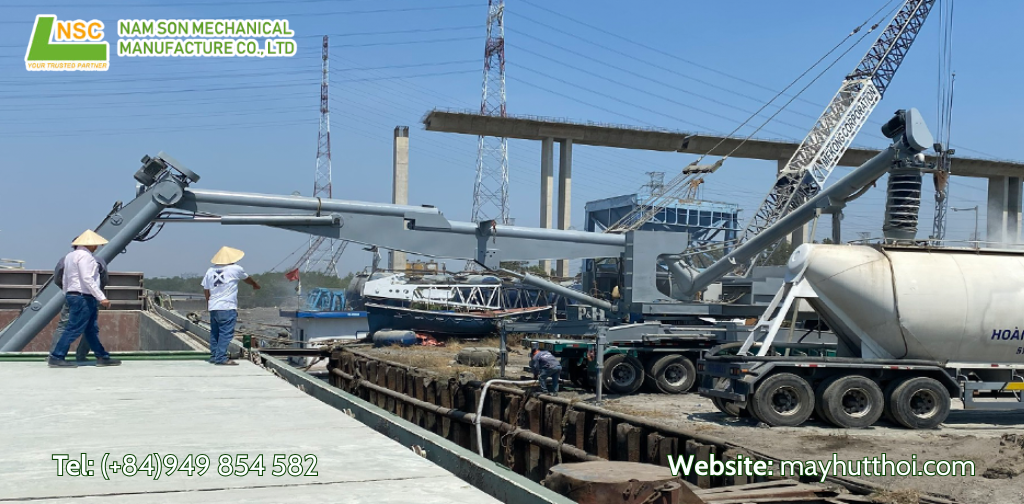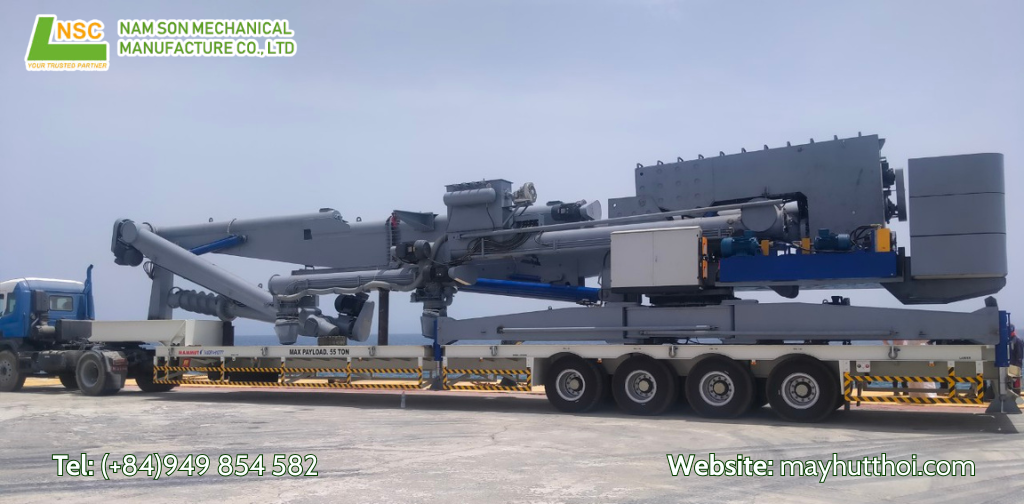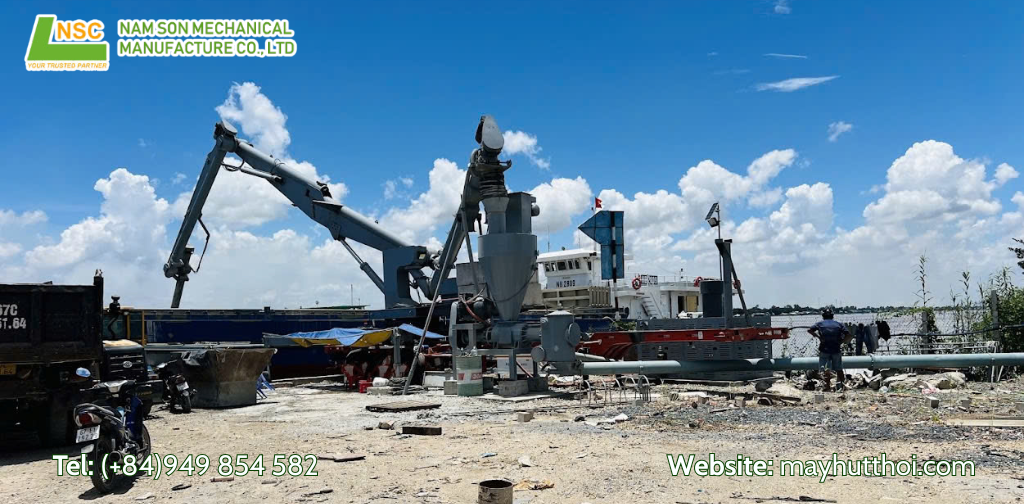In modern bulk handling operations, the
pneumatic cement ship unloader plays a crucial role in ensuring the fast, clean, and efficient discharge of cement from vessels to onshore silos. However, like any high-performance industrial system, its reliability and efficiency depend heavily on
proper maintenance and cleaning practices.
Routine inspection and cleaning are not optional—they are essential. A well-maintained
cement unloading system ensures
a dust-free operation, improved energy efficiency, a longer service life, and
safe unloading performance.
This article provides a comprehensive guide to the
best practices for pneumatic cement ship unloader maintenance and cleaning, helping operators maintain high performance, reduce downtime, and protect their investment in port infrastructure.
Overview of the pneumatic cement ship unloader system
A
pneumatic cement ship unloader works on the principle of
pneumatic conveying, using a controlled air stream—either through vacuum or pressure—to transfer dry bulk cement from the ship’s hold to onshore silos.
The main components of a pneumatic unloader typically include:
⟣ Vacuum pump or air compressor system – to generate airflow.
⟣ Suction nozzle and conveying pipeline – to transport cement powder.
⟣ Rotary valve, filter receiver system, and dust control system – to separate, regulate, and clean the air-cement mixture.
This design enables high throughput while maintaining a
dust-free unloading process, which is critical in cement handling terminals.
However, accumulated cement dust or insufficient cleaning can lead to
pipeline blockages,
air leaks, or
pressure losses, all of which reduce system performance and increase operational costs.
=>SEE MORE:What is a ship unloader? A complete guide to its function and applications

Importance of regular maintenance and cleaning
Consistent maintenance is the backbone of a reliable
cement unloading system. Operating in a harsh, dusty environment means components are constantly exposed to abrasive fine powder that can wear down mechanical and pneumatic parts over time.
A proactive
preventive maintenance program helps avoid costly repairs and unplanned downtime. The main benefits include:
✦ Early detection of pipeline wear or loose joints.
✦ Continuous performance of the pneumatic conveying blower and valves.
✦ Stable and dust-free unloading system for environmental compliance.
✦ Extended equipment lifespan and reduced operational costs.
Neglecting maintenance or improper cleaning can result in
blockages,
pressure drops, and inefficient unloading cycles. The system may also emit excess dust, violating environmental safety standards.
=>SEE MORE: 5 common errors when operating a cement ship unloader and how to fix them

Step-by-step maintenance and cleaning procedures
To ensure long-term reliability, a structured maintenance and cleaning program must be followed. The following steps outline the standard routine for
pneumatic cement ship unloader maintenance.
1. Daily and weekly maintenance tasks
Daily and weekly inspections focus on immediate operational reliability.
Key actions include:
• Check suction hoses, air filters, and valves for leaks, blockages, or cracks.
• Clean the filter receiver and hopper to prevent cement buildup.
• Inspect the vacuum line and pressure gauges for pressure stability.
• Verify that the dust collection system and filter unit are functioning properly.
These tasks maintain stable airflow, minimize wear, and prevent system contamination. Performing small, consistent checks avoids expensive long-term failures.
2. Monthly and annual maintenance
Monthly and annual maintenance tasks focus on in-depth inspection, component replacement, and calibration.
• Replace filter cartridges and clean or replace rotary valves as necessary.
• Lubricate airlock valves and inspect the conveying blower for vibration or noise.
• Calibrate the PLC control system to maintain optimal pressure and flow rates.
• Examine the air compressor system for leaks, moisture buildup, or motor wear.
• Inspect the conveying pipeline and gasket connections to ensure airtight sealing.
These activities ensure
maximum unloading efficiency and prevent system degradation over time. Proper documentation of each maintenance cycle also improves traceability and safety compliance.

3. Cleaning procedures for cement residue
Cleaning is not merely about aesthetics—it directly affects performance and product quality. Residual cement can harden inside the conveying lines, causing pressure loss and contamination.
Recommended cleaning practices include:
• Use
compressed air cleaning or a
vacuum cleaning system to remove fine
cement dust from pipelines.
• Pay special attention to
airslide conveying sections,
filter receiver, and
hopper areas where material buildup is most common.
• After cleaning, check
air pressure levels,
valve sealing, and
pipeline integrity.
Regular cleaning minimizes contamination, improves
airflow consistency, and extends the lifespan of wear components.
4. Safety during maintenance and cleaning
Maintenance and cleaning activities must always follow strict safety protocols to prevent accidents.
• Always depressurize and disconnect the system before performing any maintenance.
• Follow lock-out/tag-out procedures to avoid accidental startups.
• Use appropriate personal protective equipment (PPE) such as respirators, gloves, and goggles.
• Ensure adequate ventilation during cleaning and inspect explosion-proof pneumatic systems regularly.
Safety should never be compromised, especially when dealing with
pressurized air systems and fine cement dust that can create explosive conditions.

Key tips for optimizing equipment life
Maximizing the lifespan and performance of a
pneumatic cement ship unloader requires consistent attention to both operation and maintenance discipline.
o Establish a maintenance schedule based on actual operating hours and environmental conditions.
o Record and analyze system performance logs to identify gradual efficiency drops.
o Use genuine spare parts from the original equipment manufacturer (OEM).
o Conduct periodic training for operators on proper handling and inspection techniques.
o Evaluate energy-efficient unloading strategies to reduce power consumption.
When maintained properly, the pneumatic unloader achieves high
unloading efficiency, reduces downtime, and maintains stable conveying performance over years of heavy use.
=>SEE MORE: A beginner's guide to cement ship unloading systems
Conclusion
Proper
maintenance and cleaning of pneumatic cement ship unloaders are essential to ensure long-term reliability, safety, and performance. Regular inspection, timely cleaning, and adherence to preventive maintenance schedules protect the system from premature wear and unplanned breakdowns.
By following these best practices, operators can achieve:
✧ Stable and efficient port handling operations.
✧ Reduced maintenance costs and energy consumption.
✧ Longer service life of pneumatic conveying components.
✧ Compliance with environmental and safety standards.
Ultimately, a clean and well-maintained
cement unloading system is not just about preventing failures—it’s about ensuring continuous, dust-free, and efficient bulk handling at every port terminal.
Contact Us for Expert Pneumatic Unloader Support
Ensure your port operations run at peak efficiency. Contact our team today for professional inspection, preventive maintenance, and complete cleaning solutions for your pneumatic cement ship unloader. CONTACT US
✱ Website: mayhutthoi.com|
namsonco.com✱ Alibaba: dthson.trustpass.alibaba.com✱ Facebook: facebook.com/NamSonPneumaticConveyor✱ Zalo/Whatsapp:(+84) 949854582
✱ Email: mailan@namsonco.com | thanhson@namsonco.com






